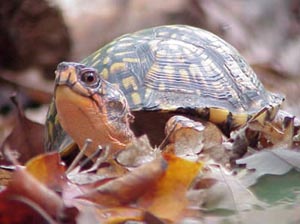
by Kalyn Waters | Apr 29, 2022

Box Turtle. Photo Credit J.D. Willson, University of Georgia
Growing up, or even as an adult there is something exciting about seeing a turtle on the road! We always want to stop and check it out or even help it across. Box Turtles are common in all parts of the southeastern United States. There are four subspecies of box turtles that can be found east of the Mississippi River. Here are three interesting topics about our common box turtles:
Reproduction
With spring in the air and the temperatures rising, they are on the move. There movement is in part due to spring being the beginning of their mating season. In the southeast males and females will mate from spring into the fall. Males will mate with one or multiple females. Amazingly females can lay fertile eggs up to four years following one successful mating! Normal incubation of the eggs typically takes three months.
Lifespan
Box turtles are well developed at birth. As soon as the hatch the start to mature and will grow at a rate of about ½ an inch per year for the first five years. While growth slows dramatically after that, they will continue to grow until they are about 20 years old. It is believed that some box turtles will live to be over 100 years old.
Home Range
While our box turtle friends live a long time, they are homebodies! Their entire home range is typically 250 yards in diameter or less. It is normal to see an overlap of home ranges for box turtles, regardless of sex or age. Keeping in mind the small home range of turtles and their limited ability to travel long distances, you should never pick them up and take them to a new area. If they are crossing a road, only set them to the other side, do not relocate them. In addition, turtles found crossing the roads in June and July are likely pregnant females. These females are likely searching for a nesting site when they are found.
As we move into spring and summer, turtles will become more active. Keep in mind that we should always leave turtles in the wild. They live longer healthier lives and can contribute to their breeding population. Likewise, you should never release a captive turtle into the wild as it will likely not survive and may introduce diseases.
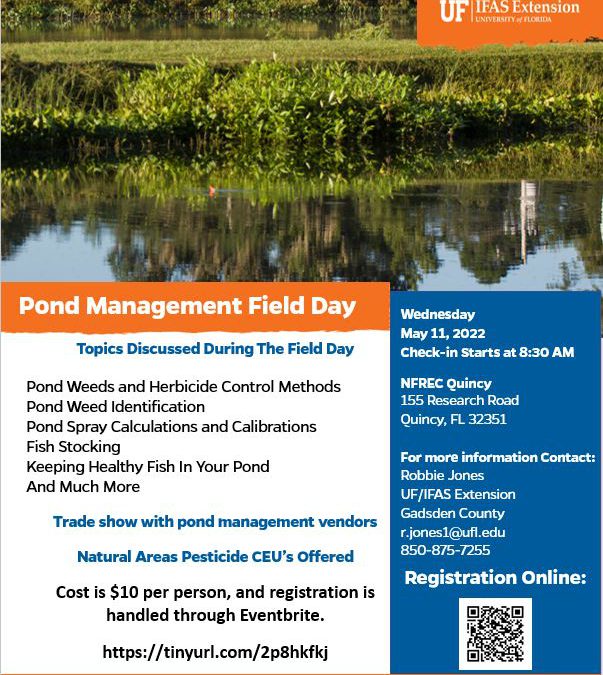
by Ray Bodrey | Apr 25, 2022
A Pond Management Field Day will be held May 11, 2022, at the North Florida Research and Education Center, in Quincy, Florida. The field day will include pond demonstrations and classroom workshops on weed prevention, sprayer calibrations, and fish stocking and management. There will also be a trade show with vendors as well as pond water testing and weed identification. The field day will also provide Pesticide CEU’s for natural areas. Registration for the Field Day is through Eventbrite and the cost for the day is $10, which includes lunch. For questions or more information, contact Robbie Jones at the UF/FAS Extension- Gadsden County Office – 850-875-7255.

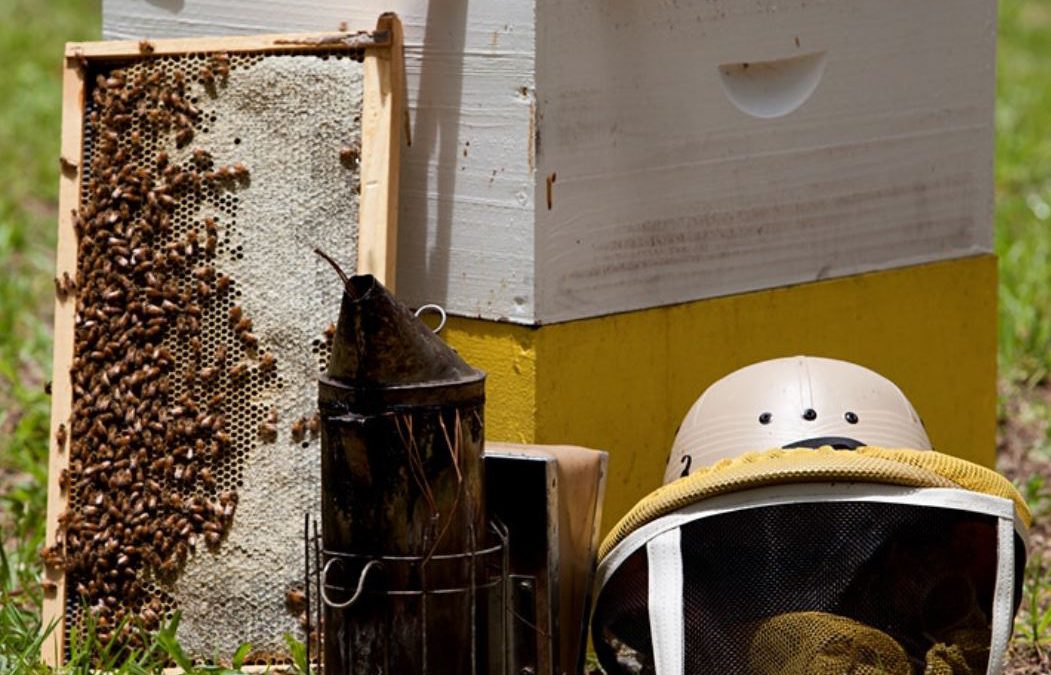
by Ray Bodrey | Apr 22, 2022
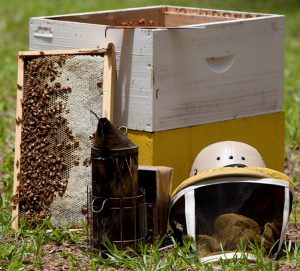
The University of Florida IFAS Extension and the Beekeeping in the Panhandle Working Group has once again teamed up to offer the 9th Annual Beekeeping in the Panhandle Conference on Friday May 6th and Saturday May 7th 2022 at the Washington County Ag Center Auditorium.
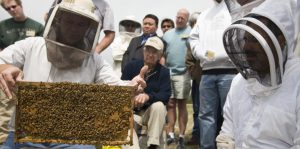
This year’s event will feature: Hands-on open hive experiences, presentations on the latest in research-based beekeeping management practices, interaction with expert beekeepers, vendors with beekeeping equipment, and hive products. Door prizes will be available as well!
The registration fee for the event will be $35 for one day or $55 for both days per person over 12, and $15 per day for kids 12 and under.
The activities will take place from 8:00 am – 5:00 pm Central each day and will include catered lunch.
Location: 1424 Jackson Avenue, Chipley, FL
Ways to register:
Registration link: https://www.eventbrite.com/e/9th-annual-beekeeping-in-the-panhandle-conference-trade-show-tickets-269199873067
Or, drop by the Washington County Extension Office in Chipley.
For more information contact Washington County Extension Office at (850) 638-6180

by Rick O'Connor | Apr 21, 2022
It is now spring, and wildlife is beginning to stir more. However, on this April day another cold front had just past the area and the morning temperature was 59°F. To add to this, there was a strong west wind that made it feel colder. Despite the fact it was an early spring morning in Florida, I had my fleece on and was dubious that I would see any reptiles.
This month’s hike was out at Big Sabine near Park East. The Gulf of Mexico was churning like a washing machine due to the passing front and the beach had a sharp scarp to it. There were a few plovers out trying to probe the sand for food, but not much else. Usually after hard winds you will find an assortment of things washed up on the beach but there was little really, possibly removed by the storm. There were however signs of digging by humans. It is now sea turtle nesting season, and we remind folks that these large holes can be a real problem for the mothers trying to nest. Please fill them in before you leave the beach.
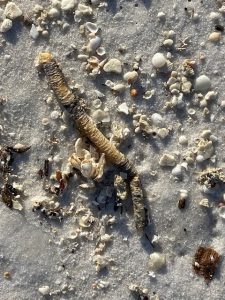
Diopatra are segmented worms similar to earthworms who build tubes to live in. These tubes are often found washed up on the beach.

Large holes like this can be problematic for many island wildlife species – like nesting sea turtles. Please fill them in when you leave for the day.
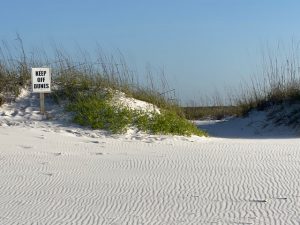
“Blow outs” are formed by people walking over the dunes. They will increase the erosion of these dunes and enhance flooding during storms. Please cross over on boardwalks.
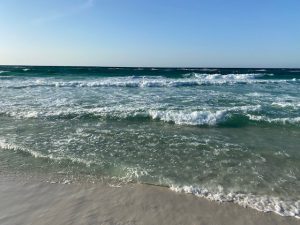
The Gulf of Mexico was churned up due to the passing cold front.
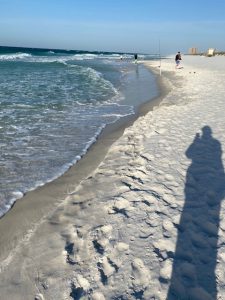
Beach scarps are formed during heavy surf changing the dynamics of the beach for creatures living there.
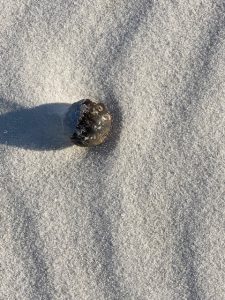
“Sea Beans” are seeds of tropical plants that wash ashore this time of year. Most do not germinate and those that do are usually on a high energy beach and do not survive.
As you head north into the dune fields the wind typically slows, but this morning it was blowing plenty hard, and I was getting “sand blasted” at some points. Not the best day to find wildlife. The sun was out and I decided to check the leeward side of shrubs and bushes, but had no luck.
One thing I did find was the sandhill milkweed in bloom. This plant is host to the monarch butterfly caterpillars and produces a mildly toxic “milk” which the caterpillars accumulate making them toxic to birds. This toxin is carried on to the adult butterfly stage and many birds learn to avoid butterflies with the monarch coloration because of the bad taste. Though I saw lots of milkweed, it was too windy for the butterflies.
The blooms of the false rosemary, which appear in late winter, had all fallen but it was obvious that the pine trees had release their pollen. Most of the scrubby pines in the dunes had new growth on them.
There were several ephemeral ponds scattered amongst the dunes. All had water in them from the recent rains and I was hoping to maybe find a basking snake or singing frog. No luck on either. There were damp areas where water had recently been, and the carnivorous sundews and spore producing club moss, known as ground pines, were doing very well.
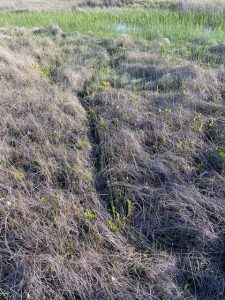
The path used by wildlife to reach the ponds of the dune field.
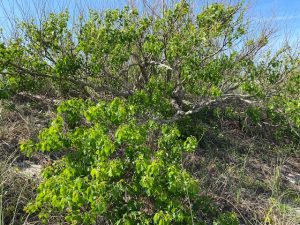
Two invasive Chinese tallow trees were found growing in the dune field. These will be removed.
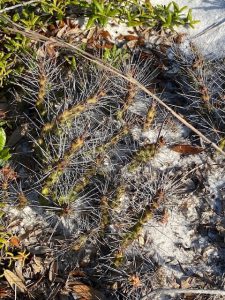
Devil’s Joint is a common cactus in the dunes. Wear shoes when exploring!
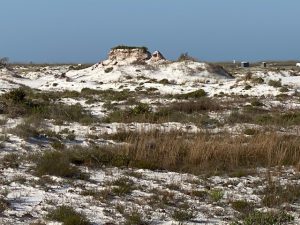
The high winds of the beach can form some interesting dunes. This one resembles the mesa’s of the American southwest.
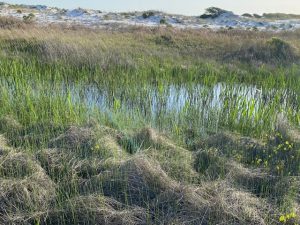
There are numerous freshwater ponds in the low areas of the dune field. Many of them are ephemeral.
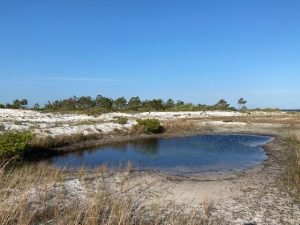
Freshwater ephemeral pond.
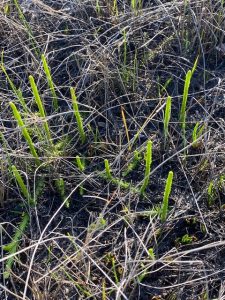
Ground pine is a type of club moss found in the wet-damp areas of the dunes.
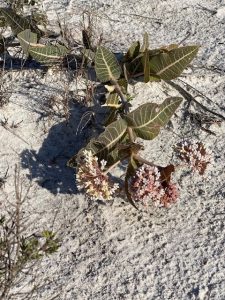
The sandhill milkweed is bloom this time of year.
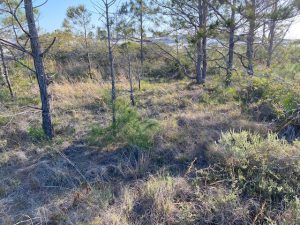
Pine scrub areas like this are found in the dune fields and are great places to find snakes and lizards.
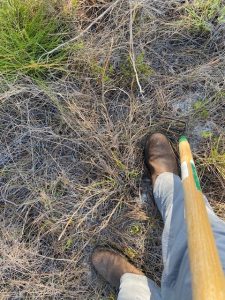
Since some of our snakes are venomous, it is recommended you wear good boots and have a hiking stick to move logs and high grass before stepping in or over.
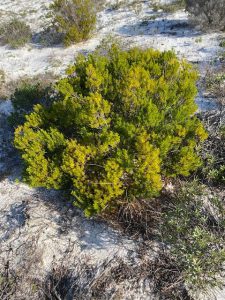
Seaside rosemary produces a wonderful smell that reminds many of the beach.
As I moved from the dunes into the maritime forest, I was expecting to see birds. I did, but not many. Most were small woodland birds I could not identify, and there was an osprey flying over briefly, but for the most part the bird action was slow today – again, probably due to the high winds. I was again hoping to maybe find a basking snake on the sunny leeward side of a bush or fallen tree but had none. I did find a common parasitic plant that was becoming more common this time of year. It is called “love-vine” or dodder. This yellow-colored string looking vine lacks chlorophyll and wraps around host plants to remove much needed nutrients. It begins to appear this time of year and is not restricted to the beaches. I have seen it 10 miles inland.
One thing that was very evident in the maritime forest was sign of armadillos. Their tracks and digs were found everywhere. I did locate a few burrows and found even more along the beach of the Sound. These animals are very abundant on this island I am curious as to what predators they have and how their populations are controlled. They can be found day or night and dig frequently looking for grubs and other invertebrates to eat. Whether they seek out turtle or bird eggs I do not know. More on this guy next month.
I will add that I did see tracks of raccoons who do eat turtle eggs and also what I think was a “slide” of an otter. The number of otter encounters has increased in recent years. Individuals have been seen not only on the beach but around Bayou Texar and Project Greenshores. These are very elusive animals and produce a high pitched “chirp” or “bark” when approached. I have seen them near Ft. Pickens on a couple of occasions in the ponds. There are the old hatchery ponds at Big Sabine, and it was there that I found the “slide”. These slides are used by the otters to slide into the water. I have seen video of them exiting the water, sliding back in, only to repeat this as if they were playing like kids – and I think that is what they are doing… playing. Otters are the largest members of the weasel family, mustelids, and pretty cool.
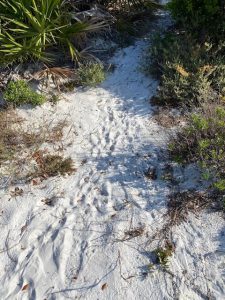
Many creatures use the same trails we do. This is a good place to look for tracks.
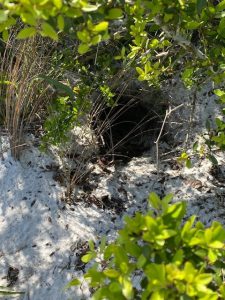
Armadillos are all over the island. This is a burrow of one.
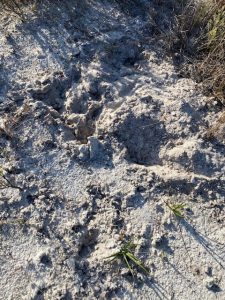
The digging of armadillos can be found everywhere as well.
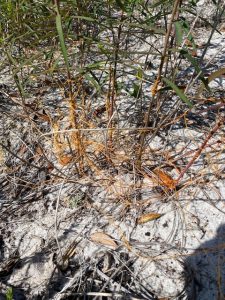
Dodder (or “love vine”) is a parasitic plant that begins to appear this time of year.
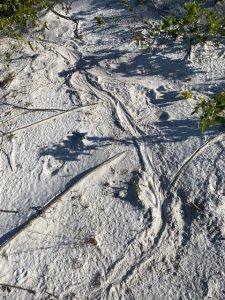
This is what I think to be an otter slide. Though I could not find tracks to confirm, I have seen them build and use these before.
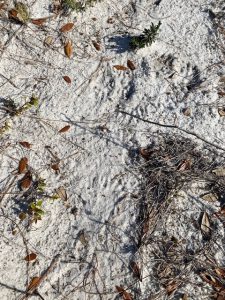
Raccoons are common all over the island.
The marsh of Big Sabine was pretty quiet on this windy day. I did see two Canadian geese walking along the shore. I recently saw several nesting on an island in Okaloosa County and was told they were now year-round residents. I am not sure whether these were residents to Big Sabine or not, I had not seen them before, but will note this as this series continues this year.
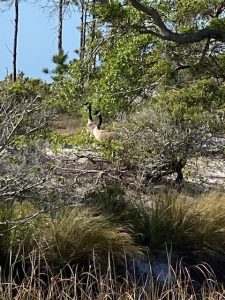
Canadian geese are becoming residents on some islands along the panhandle.
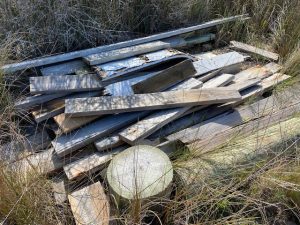
Wood piles like these can be good habitat for some beach wildlife.
The beach of Santa Rosa Sound was quiet as well. Again, I probed around to seeking a basking snake, a nesting terrapin, or maybe a nesting horseshoe crab (it was a spring tide day) but found nothing. There are piles of wood gathered by locals cleaning the beach and these actually make good habitat for some wildlife. I poked around in them but did not find anyone today. This was also where I found most of the armadillo burrows. Why they preferred this over the forested areas I am not sure. There may be many more in the forest that I just did not see. The spring tide was rising and much of the beach was exposed but I saw no fiddler crabs or other creatures and there was nothing swimming nearshore in the grass beds. Again, the lower temperatures and high winds I am sure had everyone in a warmer calmer place.
Despite little wildlife today it was a great walk and despite the high winds, the weather was actually nice. It is spring and nesting should be going on across the island. We will visit Ft. Pickens in May and see what is going on then.
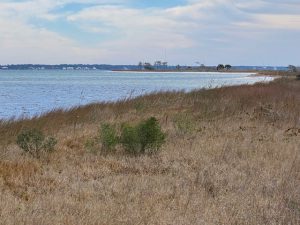
Santa Rosa Sound.
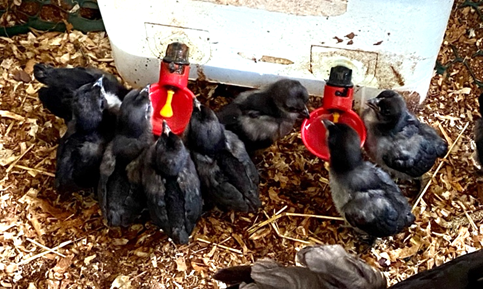
by Rick O'Connor | Apr 15, 2022
GUEST AUTHOR: PRUDENCE CASKEY – 4-H Agent in Santa Rosa County
The hot, Florida summer is approaching, and we all need to make sure we focus on hydration in the heat. Dehydration is very common in hot, humid environments. Many people do not drink the recommended amount of water. Many of us have our coffee in the morning and unless we go out to lunch and someone gives us water, we seldom think about water during the day. Another confusing concept is how much water we should drink. Growing up we were told to get eight glasses of water a day. That is 64 ounces. Let’s see if that adage still holds true today.

Animals are well aware of the need for water.
Photo: Prudence Caskey
How much water should I drink?
The best way to calculate how many ounces of water to drink is to multiply your weight by .67 or 67%. For example, a person weighing 150 pounds would need 100½ ounces or a little over 12½ cups. On the other hand, a person weighing 200 pounds would need 134 ounces or 16¾ cups.
Is that all the water I need?
No, as you sweat, you lose the water that you have already consumed. If you are sweating for 30 minutes, you need to replenish your hydration with 12 additional ounces of fluid.
What fluid should I drink?
The main thing when it comes to hydration, is to remember, just because it is wet, does not mean you are being hydrated. Different fluids are absorbed by our bodies differently. Some alcoholic beverages remove hydration from our bodies as we drink them. Below is an example of how our bodies absorb some common beverages:
- Water absorbed at 100%
- Sparkling Water absorbed at 100%
- Skim Milk is absorbed at 90%
- Buttermilk is absorbed at 90%
- Whole Milk is absorbed at 80%
- Apple Juice is absorbed at 88%
- Decaffeinated Coffee is absorbed at 90%
- Coffee is absorbed at 80%
- Sports Drinks absorbed at 50%
- Energy Drink absorbed at 40%
- Wine is absorbed at negative 150%
- Beer is absorbed at negative 60%
- Sake is absorbed at negative 180%
- Liquor is absorbed at negative 300%
This is a huge concept to grasp, if you plan on being out at the beach with your friends this summer. With this example, a well-hydrated 150-pound person consumes the required 100½ ounces of fluid. Then at a gathering, they have three, glasses of wine. The standard five ounces per glass would mean they have removed 22½ ounces from their hydration after drinking only 15 ounces of wine. Be cognoscente of what you add to your coolers this year.
What are the signs of dehydration?
There are many signs our bodies will give us to signal dehydration. Headache, nausea, and muscle pains are common. However, the most common sign of dehydration is thirst. That’s right, if you are thirsty, it is your body’s way of letting you know you need fluids. Just be careful which fluids you chose this summer when you are out and enjoying the Florida sun.
Learn more at: https://edis.ifas.ufl.edu/publication/FY1409

by Sheila Dunning | Jan 6, 2022
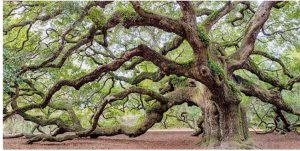
Old Live Oak
Picture from National Wildlife Foundation
The best time to plant a tree is twenty years ago. The second best time is Arbor Day. Florida recognizes the event on the third Friday in January, but planting any time before spring will establish a tree quickly.
Arbor Day is an annual observance that celebrates the role of trees in our lives and promotes tree planting and care. As a formal holiday, it was first observed on April 10, 1872 in the state of Nebraska. Today, every state and many countries join in the recognition of trees impact on people and the environment.
Trees are the longest living organisms on the planet and one of the earth’s greatest natural resources. They keep our air supply clean, reduce noise pollution, improve water quality, help prevent erosion, provide food and building materials, create shade, and help make our landscapes look beautiful. A single tree produces approximately 260 pounds of oxygen per year. That means two mature trees can supply enough oxygen annually to support a family of four.
The idea for Arbor Day in the U.S. began with Julius Sterling Morton. In 1854 he moved from Detroit to the area that is now the state of Nebraska. J. Sterling Morton was a journalist and nature lover who noticed that there were virtually no trees in Nebraska. He wrote and spoke about environmental stewardship and encouraged everyone to plant trees. Morton emphasized that trees were needed to act as windbreaks, to stabilize the soil, to provide shade, as well as fuel and building materials for the early pioneers to prosper in the developing state.
In 1872, The State Board of Agriculture accepted a resolution by J. Sterling Morton “to set aside one day to plant trees, both forest and fruit.” On April 10, 1872 one million trees were planted in Nebraska in honor of the first Arbor Day. Shortly after the 1872 observance, several other states passed legislation to observe Arbor Day. By 1920, 45 states and territories celebrated Arbor Day. Richard Nixon proclaimed the last Friday in April as National Arbor Day during his presidency in 1970.
Today, all 50 states in the U.S. have official Arbor Day, usually at a time of year that has the correct climatological conditions for planting trees. For Florida, the ideal tree planting time is January, so Florida’s Arbor Day is celebrated on the third Friday of the month. Similar events are observed throughout the world. In Israel it is the Tu B Shevat (New Year for Trees). Germany has Tag des Baumes. Japan and Korea celebrate an entire week in April. Even Iceland, one of the most treeless countries in the world observes Student’s Afforestation Day.
The trees planted on Arbor Day show a concern for future generations. The simple act of planting a tree represents a belief that the tree will grow and someday provide wood products, wildlife habitat, erosion control, shelter from wind and sun, beauty, and inspiration for ourselves and our children.
“It is well that you should celebrate your Arbor Day thoughtfully, for within your lifetime the nation’s need of trees will become serious. We of an older generation can get along with what we have, though with growing hardship; but in your full manhood and womanhood you will want what nature once so bountifully supplied and man so thoughtlessly destroyed; and because of that want you will reproach us, not for what we have used, but for what we have wasted.”
~Theodore Roosevelt, 1907 Arbor Day Message




































